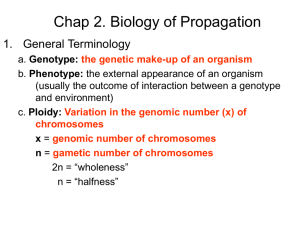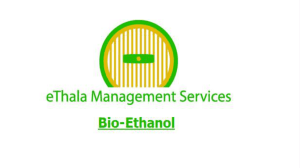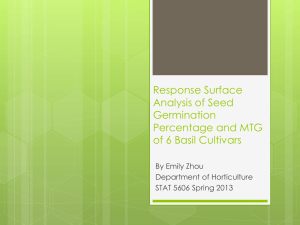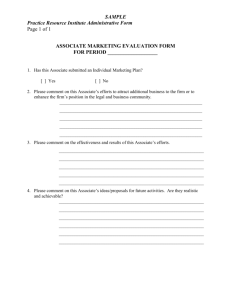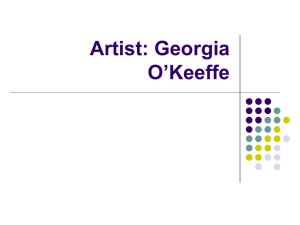Policy No.9 Cultivar/Germplasm Release Application
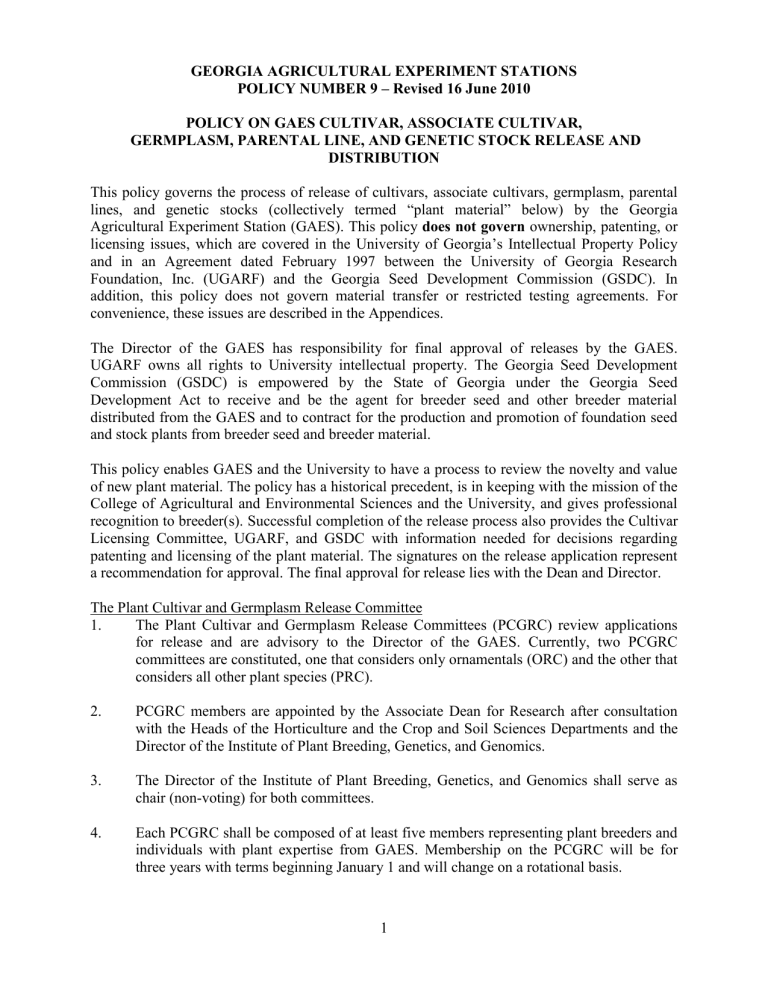
GEORGIA AGRICULTURAL EXPERIMENT STATIONS
POLICY NUMBER 9 – Revised 16 June 2010
POLICY ON GAES CULTIVAR, ASSOCIATE CULTIVAR,
GERMPLASM, PARENTAL LINE, AND GENETIC STOCK RELEASE AND
DISTRIBUTION
This policy governs the process of release of cultivars, associate cultivars, germplasm, parental lines, and genetic stocks (collectively termed “plant material” below) by the Georgia
Agricultural Experiment Station (GAES). This policy does not govern ownership, patenting, or licensing issues, which are covered in the University of Georgia’s Intellectual Property Policy and in an Agreement dated February 1997 between the University of Georgia Research
Foundation, Inc. (UGARF) and the Georgia Seed Development Commission (GSDC). In addition, this policy does not govern material transfer or restricted testing agreements. For convenience, these issues are described in the Appendices.
The Director of the GAES has responsibility for final approval of releases by the GAES.
UGARF owns all rights to University intellectual property. The Georgia Seed Development
Commission (GSDC) is empowered by the State of Georgia under the Georgia Seed
Development Act to receive and be the agent for breeder seed and other breeder material distributed from the GAES and to contract for the production and promotion of foundation seed and stock plants from breeder seed and breeder material.
This policy enables GAES and the University to have a process to review the novelty and value of new plant material. The policy has a historical precedent, is in keeping with the mission of the
College of Agricultural and Environmental Sciences and the University, and gives professional recognition to breeder(s). Successful completion of the release process also provides the Cultivar
Licensing Committee, UGARF, and GSDC with information needed for decisions regarding patenting and licensing of the plant material. The signatures on the release application represent a recommendation for approval. The final approval for release lies with the Dean and Director.
The Plant Cultivar and Germplasm Release Committee
1. The Plant Cultivar and Germplasm Release Committees (PCGRC) review applications for release and are advisory to the Director of the GAES. Currently, two PCGRC committees are constituted, one that considers only ornamentals (ORC) and the other that considers all other plant species (PRC).
2. PCGRC members are appointed by the Associate Dean for Research after consultation with the Heads of the Horticulture and the Crop and Soil Sciences Departments and the
Director of the Institute of Plant Breeding, Genetics, and Genomics.
3. The Director of the Institute of Plant Breeding, Genetics, and Genomics shall serve as chair (non-voting) for both committees.
4. Each PCGRC shall be composed of at least five members representing plant breeders and individuals with plant expertise from GAES. Membership on the PCGRC will be for three years with terms beginning January 1 and will change on a rotational basis.
1
a. b.
GEORGIA AGRICULTURAL EXPERIMENT STATIONS
POLICY NUMBER 9 – Revised 16 June 2010
The PRC will include :
At least three plant breeders, including one each from Athens, Griffin and Tifton, and at least one from Horticulture and one from Crop and Soil Sciences.
One state extension faculty member
One member-at-large (USDA/ARS or GAES scientist with a background in plant breeding and/or genetics)
The Director of the Georgia Seed Development Commission (ex-officio)
The Director of the Georgia Crop Improvement Association (ex-officio)
The ORC will include :
At least five voting members with a science background in plant breeding/genetics or plant science, with at least one from Horticulture and one from Crop and Soil Sciences.
The Director of the Georgia Seed Development Commission (ex-officio)
The Director of the Georgia Crop Improvement Association (ex-officio)
4. The Heads of the Horticulture and the Crop and Soil Sciences Departments may serve as ex-officio members of the PCGRC.
5. Applications to the PRC will be requested from the faculty on January 2 and July 1 each year. Applications are due to the PRC Chair on January 15 and July 15. The PRC meets twice a year around February 1 and August 1. The ORC accepts applications any time during the year.
In both cases, applications will be distributed to committee members and a meeting date scheduled for the committee to discuss and vote on the submission. Applications will also be forwarded to UGARF when they are distributed to the committee. The committee decision and feedback will then be sent by the committee chair to the release requester.
Every attempt is made to keep the time from submission to notification under 30 days.
6. If plant material needs to be considered by the PCGRC outside normal procedures, the breeder needs to contact the appropriate PCGRC Chair. These special requests will be handled on a case-by-case basis and must be accompanied by strong justification.
Process following GAES release of plant material
1. After the approval process is complete (i.e., the Dean and Director has signed the application), a Cultivar Licensing Committee (governed by the Agreement between
UGARF and GSDC) will meet to begin the licensing and distribution process.
2. Plant material may be developed under the terms of a sponsored research agreement that grants the sponsor an option to acquire an exclusive or non-exclusive commercial license from UGARF. UGARF will administer and approve all sponsored cultivar development agreements.
3. Plant material may be protected as intellectual property. Plant material having potential
2
Breeder responsibility following release
1. The breeder shall be responsible for developing and maintaining Breeder’s Seed Stocks or parent material, and for providing breeder seed in suitable quantity exclusively to the
GSDC, or in the case of vegetative propagation material, in suitable quantity to the
GSDC or to nurseries mutually agreed upon by the breeder and GSDC. GSDC and/or the selected nurseries will then multiply and distribute seed or plants in accordance with
GAES and GSDC’s policies.
2.
GEORGIA AGRICULTURAL EXPERIMENT STATIONS
POLICY NUMBER 9 – Revised 16 June 2010 for intellectual property protection will be disclosed to UGARF and administered according to the University of Georgia Intellectual Property Policy (see Appendix).
In cases where a new line appears worthy of release after two years’ evaluation, the breeder may supply Breeder Seed or parent material (see Definitions on page 8) to the
GSDC upon approval by the Director and agreement with GSDC that seed or plant material increase will be disposed of in a manner which will not be embarrassing to the
University in case the proposed cultivar or associate cultivar is not officially released.
3. The breeder will be responsible for preparing and sending to the Georgia Crop
Improvement Association (GCIA) the description of the cultivar for the purpose of establishing certification standards.
4. If intellectual property protection is desired, the breeder will submit a Disclosure Form to
UGARF.
5. The breeder is encouraged to prepare a registration article submitted to an appropriate peer-reviewed publication.
3
GEORGIA AGRICULTURAL EXPERIMENT STATIONS
POLICY NUMBER 9 – Revised 16 June 2010
APPLICATION PROCEDURE
A.
Breeder’s Responsibility
1. Obtain and assemble experimental data and prepare release application concerning the cultivar, associate cultivar, germplasm, parental line, or genetic stock (Attachment I). The application must be filled out as completely and accurately as possible, with special care given to the justification for release (Item
No. 6), as this information will be central to the committee’s deliberations. The statements made in the description (Item No. 4) and the justification (Item No. 6) must be supported by statistically valid data presented as tables or figures or other commonly accepted forms of scientific data relevant for the plant material. In other words, breeders are urged to “SUPPORT YOUR CLAIMS.”
2. Forward application to the appropriate department head and, for breeders at
Griffin and Tifton the appropriate assistant dean, for approval and signature.
3. Simultaneously, inform the chairperson of the appropriate PCGRC, Agronomic or
Ornamental, of the submission.
4. If requested by the chairman of the PCGRC considering the application, attend the PCGRC meeting and formally present evidence supporting a proposed cultivar or associate cultivar release.
B. Department Head’s and (at Griffin and Tifton) Assistant Dean’s Responsibility
1.
Review breeder’s application with the executive committee and/or appropriate commodity committees.
2. Ensure that the genetic material was developed with GAES funds and that the application includes appropriate collaborators involved in developing the genetic material.
3. If approved, forward applications to the appropriate Plant Cultivar and
Germplasm Release Committee Chair.
C. Plant Cultivar and Germplasm Release Committee (PCGRC) Responsibility
1. Critically review proposals for release and naming of cultivars and associate cultivars approved by the Department Head.
2. Forward recommendation of PCGRC along with supporting documents to the
Associate Dean for Research.
D. Associate Dean’s Responsibility
4
1.
GEORGIA AGRICULTURAL EXPERIMENT STATIONS
POLICY NUMBER 9 – Revised 16 June 2010
Review the PCGRC recommendations and forward recommendations to the Dean and Director.
E. Dean and Director’s Responsibility
1. Approve or disapprove the release of the genetic material.
2. For cultivars, request the Certification Committee and Board of Directors of
Georgia Crop Improvement Association (GCIA) to approve the cultivar for certification, if applicable to crop concerned.
F.
Georgia Seed Development Commission’s (GSDC) Responsibility
1. Multiply and distribute seed or plants in accordance with GAES and
GSDC’s policies .
5
1.
2.
3.
4.
5.
6.
GEORGIA AGRICULTURAL EXPERIMENT STATIONS
POLICY NUMBER 9 – Revised 16 June 2010
INFORMATION FOR COMPLETING APPLICATIONS
Crop:
Provide the name of the crop including scientific binomial.
Experimental no. or name:
Provide the number or name under which the germplasm has been tested.
Pedigree and history:
Present a brief description of the parental materials going into the plant material and outline the procedures used in developing the new product (hybridization, selection, polycross, synthetic, etc.). If applicable, provide a description of the origin of breeder seed that will be provided to GSDC or other agency for increase.
Description of plant material:
Include specific characteristics, such as morphological traits, that enable the differentiation of this material from other cultivars and that could be used by inspection or certification agencies. Evidence of uniformity, stability, and type and frequency of variants needs to be included, as is required in the Plant Variety Protection Certificate application.
Need for and potential users of plant material
Provide a brief description regarding the need for the new plant material and who may be expected to use the material. Include a description of the intended geographic region of commercialization.
Reasons for release:
Indicate the primary reason(s) for releasing the plant material. Improvement in one agronomically or horticulturally important trait is sufficient grounds for release. For cultivars, describe how the new cultivar is superior/unique to the cultivar(s) now in use.
For associate cultivars, describe the reasons for proposing release as an associate cultivar.
Indicate commercial parties who have expressed an interest in the germplasm. For germplasm, parental lines, or genetic stocks, describe the specific characteristics that merit release.
For all plant material, include appropriate and adequate data comparing proposed release to standard plant material with the application. Qualitative phenotypic traits, such as a unique flower or foliage color, can best be documented with photos and a corresponding review of or comparison to currently available germplasm. Use of a recent edition of the
Royal Horticultural Society Colour Chart is encouraged to describe color characteristics.
The RHS chart can be purchased at: http://shop.wisley.co.uk/products.php?maincat=RHS%20COLOUR%20CHARTS&prod uct=RHS_COLOUR_CHARTS. Quantitative traits require adequate documentation including industry standard cultivar comparative data. Multiple year and multiple location data is usually expected, especially when claims of pest and or disease resistance
6
GEORGIA AGRICULTURAL EXPERIMENT STATIONS
POLICY NUMBER 9 – Revised 16 June 2010 are involved. All data should be presented in journal-quality tables and figures that are clearly marked, including table descriptions and footnotes where needed. Statistical analysis of data greatly enhances the credibility of claims and is strongly encouraged.
For cultivars and associate cultivars , the following information should be included with the application: a. The yield performance ratings must be based on appropriate data for the plant species. In cases where the plant material has been tested in other states, data from other states may make up a portion of the data if approved by the commodity committee concerned. Tabular data with adequate statistics and a written statement of the breeder’s interpretation of the data shall accompany the proposed release. Provide comparisons of the proposed release to other major cultivars; complete trial reports are not necessary. b. Disease and insect reactions. The originator shall provide data describing the reaction of the proposed plant material to attack by disease and insects. Any tendency toward higher susceptibility to damage by disease or insects than currently grown cultivars should be presented. c. Reactions to adverse weather. The originator shall report the relative susceptibility of the proposed cultivar or associate cultivar to drought or excessive rainfall if either has been encountered during the past 3 years of testing. The relative winter hardiness of perennials and winter annuals should be presented. Where cold susceptibility may be a problem, the originator should outline the areas of the state in which the cultivar or associate cultivar may safely be grown. d. Defects. The originator must list all known defects (whether covered elsewhere or not). Where serious defects are present, the originator should present a statement explaining why the proposed cultivar or associate cultivar should be released even though it may have certain defects.
For germplasm , provide data to support the “claim of uniqueness” of the germplasm compared with the existing standard (e.g., a pest resistant germplasm should have replicated data showing resistance compared to a susceptible and the “best” available resistant check). Provide description of available markers or plant phenotype to describe the germplasm.
For parental lines , if the line is to be used to create a specific hybrid cultivar, provide data on the performance and characteristics of the parental line and hybrid cultivar. The value of a parental line used to create a specific hybrid cultivar will be the performance of the improved hybrid cultivar compared to that of the existing hybrid cultivars. If the parental line is to be used with unspecified parents to create hybrid cultivars, provide data to support its general combining ability for the most important traits. If a parental line is to be used as a female parent for hybrid seed production, provide data on yield of hybrid seed compared to the hybrid seed production of other commonly used female parents.
7
GEORGIA AGRICULTURAL EXPERIMENT STATIONS
POLICY NUMBER 9 – Revised 16 June 2010
For genetic stocks , provide inheritance data for the phenotype produced by the specific gene(s) unique to the genetic stock.
7. Participating scientist(s):
Include the scientists who contributed to the plant material development. If the release is to be a joint release with any other experiment station or with the USDA-ARS, the breeder should prepare and submit to the appropriate Department Head a joint release notice with signature lines for all approving stations or agencies.
8. Location(s) at which plant material was developed:
List the Campus(es) and/or Research and Education Center(s) at which the plant material was developed.
9. Recommended form of intellectual property protection and royalty:
If appropriate, recommend the preferred form of intellectual property protection to be requested and if a royalty should be assessed.
Cultivar and associate cultivar applications only provide the following information :
10. Method of propagation:
Describe how the cultivar/associate cultivar will be propagated.
11. Amount of breeder seed stocks available (if applicable):
State quantities.
12. Amount of foundation seed stocks available (if applicable):
State quantities.
13. Amount of cutting or bud material available for vegetatively propagated material for nursery distribution (if applicable):
State quantities
14. Describe any unusual difficulty anticipated in the production of any class of seed stocks:
List any possible problems.
15. Suggest up to three names for the cultivar, if appropriate:
Recommend a prioritized list of one or more names for the cultivar or associate cultivar, using the American Society for Horticultural Science and American Seed Trade
Association guidelines for naming cultivars. Cultivars and associate cultivars may retain their experimental number when an exclusive license is anticipated (to allow the exclusive licensee to name the cultivar or associate cultivar).
16. Name approved by plant cultivar and germplasm release committee:
This will be completed by the PCGRC Chair following review.
8
GEORGIA AGRICULTURAL EXPERIMENT STATIONS
POLICY NUMBER 9 – Revised 16 June 2010
DEFINITIONS
Associate Cultivars: Recent changes in GAES policy allow release of associate cultivars via the
GSDC to commercial seed companies and/or grower associations with a limited distribution agreement. The word “associate” was chosen to imply that the cultivar may have many traits equal to the best cultivar in production but lack one or more pest resistance or quality factors that are important in some but not all production environments. The associate cultivar class is intended to include sister lines of released cultivars and lines of different parentage than released cultivars. Associate cultivars, like all PVP, or plant patent-protected cultivars, must be phenotypically distinguishable from cultivars already in production. Associate cultivars will provide breeders of some crops (e.g. crops with viable seed industry in Georgia) the opportunity to generate funds to enhance their breeding programs resulting in expanded breeding efforts and improved cultivars for Georgia growers. Release of associate cultivars will also result in improved genetic material being made available to commercial seed organizations and through them to the farm community.
Breeder Seed: Seed from a plant breeder which is used to maintain or increase the seed stocks of a cultivar or parental line. Breeder seed refers to sexually reproduced cultivars.
Cultivar: A group of plants with characteristics that are distinct, uniform, and stable. “Distinct” indicates that the cultivar can be differentiated by one or more identifiable morphological, physiological, or other characteristics from other standard cultivars. “Uniform” designates that variation among the plants of a cultivar for distinctive characteristics can be described. “Stable” indicates that the cultivar will remain unchanged to a reasonable degree of reliability in its distinctive characteristics and its uniformity when reproduced or reconstituted.
Genetic Stocks: Genetic stocks consist of morphologial, physiological, and chemical mutants, as well as aneuploid lines, isoline pairs, and representative cytoplasmic male-sterile lines.
Germplasm: Germplasm must have been improved by breeding procedures. It must possess some demonstrable merit, but need not be commercially viable in its present form. Germplasm need not be distinct, uniform, or stable.
Parent Material: A plant or plants identified by a plant breeder or discoverer from which vegetative propagules are obtained to maintain and increase a cultivar. Parent material refers to asexually reproduced cultivars.
Parental Lines: Parental lines must have demonstrated utility in applied breeding programs. A parental line, as opposed to germplasm, will be used directly as a parent to produce a hybrid cultivar.
9
GEORGIA AGRICULTURAL EXPERIMENT STATIONS
POLICY NUMBER 9 – Revised 16 June 2010
DISPOSING OF PLANT BREEDING MATERIALS
Upon announcement of a resignation or retirement of a Georgia Agricultural Experiment
Stations’ scientist dealing with germplasm enhancement or cultivar development, the Director of the GAES shall appoint the appropriate department head(s) to immediately assume direct responsibility for all germplasm, breeding lines, genetic material and potential cultivars in that program. The department head(s), with appropriate input (e.g., the breeder, commodity breeders within the state and the extension specialist, etc.) should develop a plan for the disposition of these materials. This plan should be approved by the PCGRC with final approval by the Director of GAES.
10
GEORGIA AGRICULTURAL EXPERIMENT STATIONS
POLICY NUMBER 9 – Revised 16 June 2010
CURRENT COMMITTEE MEMBERSHIP
The current PCGRC committees consist of the following members:
1. The current Chair of the PCGRC is Charles Brummer, Department of Crop and Soil
Sciences, Athens and Director of the Institute of Plant Breeding, Genetics, and Genomics.
Current committee members (with year of appointment) are Cecelia McGregor (2010),
Roger Boerma (2009), Brian Schwartz (2010), Scott NeSmith (2010), and John Beasley
(2008).
2. The current Chair of the Ornamental Release Committee is Charles Brummer,
Department of Crop and Soil Sciences, Athens and Director of the Institute of Plant
Breeding, Genetics, and Genomics. Current committee members (with year of appointment) are Alan Armitage (2010), Matthew Chappell (2009), Carol Robacker
(2008), John Ruter (2008), and Wayne Parrott (2009).
11
GEORGIA AGRICULTURAL EXPERIMENT STATIONS
POLICY NUMBER 9 – Revised 16 June 2010
APPENDIX 1. Licensing of GAES released germplasm through UGARF
[This description is provided here simply to clarify the process by which cultivars are licensed through UGARF. This is not a function of the GAES, however, and thus not a part of Policy 9.]
In 1997, UGARF entered into an agreement (the “Agreement”) with the GSDC, whereby GSDC would administer licenses with commercial seedsmen to produce and publicly sell certified seed and parent material protected under the UGA Intellectual Property Policy. The scope of the
Agreement covers all cultivars released from GAES which are to be protected by Plant Variety
Protection Certificates, plant patents or utility patents.
The Agreement requires that the Cultivar License Committee make certain decisions related to licensing cultivars and other plant material released from GAES. The Committee is comprised of the breeder, a representative from each of GAES, UGARF, and GSDC, the Commissioner of the
Georgia Department of Agriculture, and the Executive Vice President of UGARF (the latter two positions were added in an amendment to the Agreement in 2007) and considers each cultivar individually to determine the most desirable means of release and distribution. The specific terms of each cultivar license are set by UGARF and GSDC.
The GAES representative will provide each member of the License Committee a copy of the
Cultivar Release or Associate Cultivar Release prior to the convening of a License Committee meeting.
Under Article 4 of the Agreement, the Licensing Committee will meet and agree whether the cultivar will be protected by Plant Variety Protection Certificate, Plant Patent, Trade Secret, or
Utility Patent; and, whether the protected cultivar will be licensed by exclusive or non-exclusive license.
The License Committee will take into consideration the qualifications to be required of an effective licensee, the geographic adaptation of the cultivar and the territories that can be served by extending licenses to companies outside of Georgia and outside of the U.S. Decisions on such recommendations will be made by the Licensing Committee.
APPENDIX 2. Material Transfer and Restricted Testing Agreements
Material transfer and restricted testing agreements are both used when faculty members wish to permit third parties to use University plant materials for testing and research. The restricted testing agreement is a more complex agreement used when the plant material contains significant intellectual property or if specific controls over the recipient's use are desired. Traditionally material transfer agreements were used for laboratory settings and restricted testing agreements for field settings, but the lines have blurred. Contact UGARF in order to determine which form is appropriate. It is never appropriate to share material for use by any third party without a written agreement.
12
APPLICATION FOR RELEASE
APPLICATION FOR RELEASE OF (check one):
CULTIVAR PARENTAL LINE
ASSOCIATE CULTIVAR
GERMPLASM
GENETIC STOCK
2.
3.
4.
1. Crop:
Experimental no. or name:
Pedigree and history:
Description of plant material:
7.
8.
9.
5. Need for and potential users of plant material:
6. Justification for release:
Participating scientists:
Location(s) at which plant material was developed:
Recommended form of intellectual property protection and royalty:
Cultivar and associate cultivar applications only provide the following information :
10. Method of propagation:
11. Amount of breeder seed stocks available (if applicable):
12. Amount of foundation seed stocks available if applicable:
APPLICATION FOR RELEASE
13. Amount of cutting or bud material available for vegetatively propagated material for nursery distribution (if applicable):
14. Describe any unusual difficulty anticipated in the production of any class of seed stocks:
15. Suggest up to three names for the cultivar, if appropriate:
16. Name approved by plant cultivar and germplasm release committee:
APPLICATION FOR RELEASE
(Please keep this as a separate page)
Application for the release of (insert experimental name or number and crop)
Recommended:
A. _____________________________________ ______________________
Date Originating Scientist
B. _____________________________________
Department Head
______________________
Date
C.
_____________________________________
For Griffin and Tifton, Assistant Dean
D.
_____________________________________
Chair, GAES PCGRC
______________________
Date
______________________
Date
E. _____________________________________
Associate Dean for Research
Approved:
F. _____________________________________
Dean and Director
______________________
Date
______________________
Date

